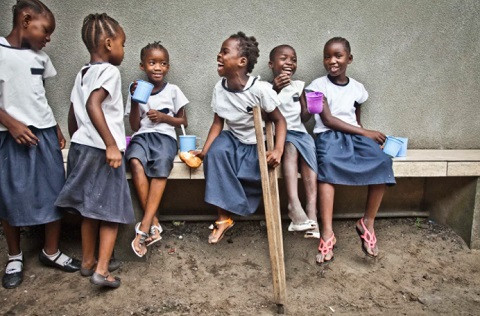
GCED Basic Search Form
Quick Search
Вы здесь
Новости

Our 2020 Gender Report, released today, shows that 180 million more girls have enrolled in primary and secondary education since the Beijing Declaration and Platform for Action, a landmark commitment to advance the rights of girls and women made in 1995 by 189 countries. Released on the occasion of the International Day of the Girl Child, which is celebrated on October 11, it shows that, despite an increase across all levels of education, girls are still more likely to suffer exclusion than boys. It therefore remains vital for governments to tackle persisting discrimination to achieve equality for the next generation of girls.
New analysis shows that the benefits of maternal education accumulate and can break the cycle of disadvantage between generations. Girls born in low-income countries in the 1980s acquired seven more months of education for every year of education their mothers received.
Education is the springboard for achieving the six Action Coalitions at the Generation Equality Forum planned for 2021, where the next iteration of the Beijing Declaration will be produced. It makes the timing of this Report particularly critical.
A high-level discussion co-hosted by the Government of France, Plan International and UNESCO is taking place this Monday 12 October, 15:00–16:30 CEST. Female leaders and young women whose lives have been transformed by gains in education made over the past 25 years will join ministers of education from Finland and Senegal and Audrey Azoulay,Director-General, UNESCO, to discuss what should be prioritised for the next generation of girls. Click here for more information and to register.
Since 1995, the global enrolment rate for girls increased from 73% to 89%, with the biggest improvements seen in sub-Saharan Africa and Southern Asia, especially in India. Significant progress has been made in primary education enrolment in 23 countries including Bhutan, Djibouti and Nepal, where gender parity has been achieved compared to 1995 when fewer than 80 girls for every 100 boys attended school.

Three times more women are also now enrolled in universities than two decades ago, with particular progress seen in Northern Africa and Western Asia. In Morocco, parity was achieved in 2018, compared to just 30 women enrolled for every 100 men in the early 1990s.
Despite encouraging progress, gender still plays a significant role in enrolment in many countries. Three-quarters of all primary-age children who may never set foot in school are girls (9 million). In Chad, Guinea-Bissau and Yemen, fewer than 80 girls for every 100 boys completed primary school and boys are more than twice as likely to complete secondary school as girls. Large gender disparities persist particularly for disadvantaged learners. In at least 20 countries, mostly in sub-Saharan Africa but also in Belize, Haiti, Pakistan and Papua New Guinea, hardly any poor rural young women have completed upper secondary school.
The heavy legacy of past discrimination and the slow speed with which recent advances trickle down to the entire population are such that women still account for almost two-thirds of illiterate adults, same as in 1995. Many also face additional barriers, such as poverty and disability. In 59 countries, women aged 15-49 from the poorest households are four times more likely to be unable to read and write than those from the richest households.
The report, A New Generation: 25 Years of Efforts for Gender Equality in Education, calls for action in six areas tightly linked to the six Action Coalitions that will form the basis for the discussion at the Generation Equality Forum in 2021: violence, economic justice and rights, sexual and reproductive health and rights, climate justice, technology and innovation, and feminist movements and leadership.
- Ensure 12 years of safe and quality education for all girls. There are fewer than 9 females enrolled for every 10 males in 4% of countries in primary, 9% in lower secondary, 15% in upper secondary and 21% in tertiary education.
- Ensure balanced representation of girls and women in technology and engineering fields of study. The share of females in these fields of study in tertiary education is below 25% in over two-thirds of countries. Invest in training for teachers and counsellors to be gender responsive.
- Remove stereotypes and gender bias from pedagogy and learning materials. Examples of girls and women in English language textbooks make up to 44% in Malaysia and Indonesia, 37% in Bangladesh and 24% in Punjab province, Pakistan. Textbook revision processes need to be inclusive, ensuring that women participate equally and that their views are heard.
- Make schools safe spaces for all girls and boys, free from gender-based violence. Violence is an obstacle to the achievement of universal secondary education and perpetuates gender-unequal norms. Fighting it requires an inclusive school ethos, clear rules about what is acceptable, preparation of teachers and head teachers, and engagement with the community, not least to improve reporting.
- Commit to delivering comprehensive sexuality education at all education levels. In 2019, 14% of 20- to 24-year-old women globally had given birth before age 18 and 25% in sub-Saharan Africa. Education must be used to promotes sexual and reproductive health and rights but governments need to overcome two challenges: fight erroneous beliefs and improve management capacity.
- Ensure balanced representation of women in education management and leadership positions. In 48 middle- and high-income countries, there is a gender gap of 20 percentage points in the share of teachers and head teachers in lower secondary schools.
The GEM Report has been running a campaign called #Iamthe1stGirl to find and share the inspiring stories of girls and women who were the first in their family to graduate. Keep watch as we post them on this blog in the coming days.
URL:
